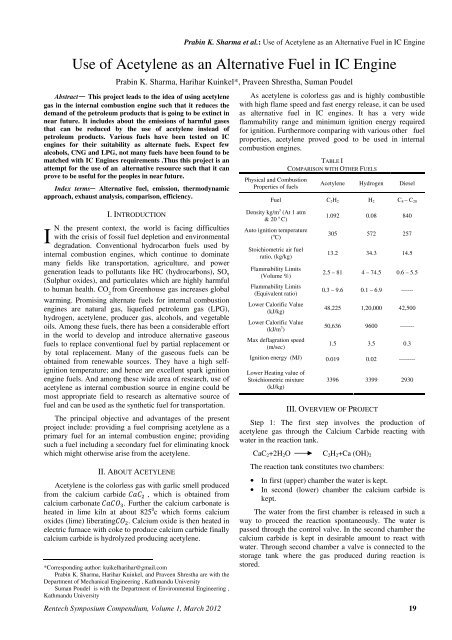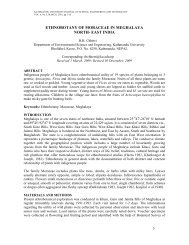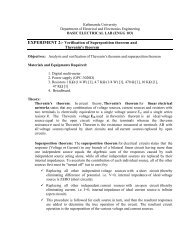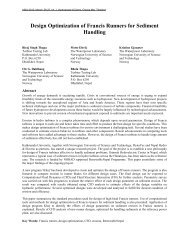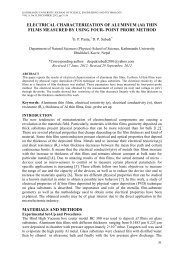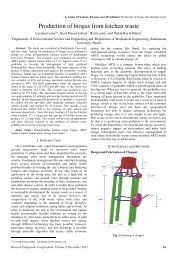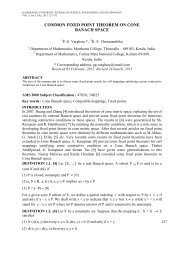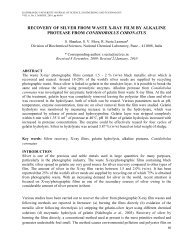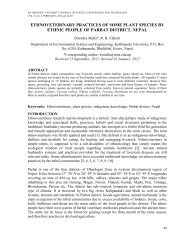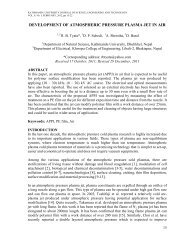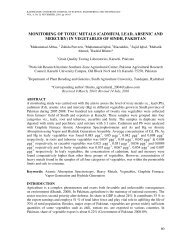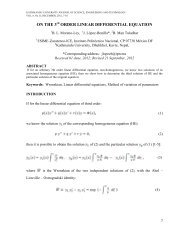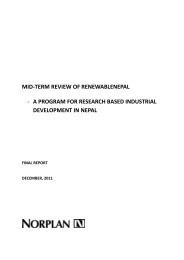Use of Acetylene as an Alternative Fuel in IC Engine - Kathmandu ...
Use of Acetylene as an Alternative Fuel in IC Engine - Kathmandu ...
Use of Acetylene as an Alternative Fuel in IC Engine - Kathmandu ...
You also want an ePaper? Increase the reach of your titles
YUMPU automatically turns print PDFs into web optimized ePapers that Google loves.
Prab<strong>in</strong> K. Sharma et al.: <strong>Use</strong> <strong>of</strong> <strong>Acetylene</strong> <strong>as</strong> <strong>an</strong> <strong>Alternative</strong> <strong>Fuel</strong> <strong>in</strong> <strong>IC</strong> Eng<strong>in</strong>e<br />
<strong>Use</strong> <strong>of</strong> <strong>Acetylene</strong> <strong>as</strong> <strong>an</strong> <strong>Alternative</strong> <strong>Fuel</strong> <strong>in</strong> <strong>IC</strong> Eng<strong>in</strong>e<br />
Prab<strong>in</strong> K. Sharma, Harihar Ku<strong>in</strong>kel*, Praveen Shrestha, Sum<strong>an</strong> Poudel<br />
Abstract— This project leads to the idea <strong>of</strong> us<strong>in</strong>g acetylene<br />
g<strong>as</strong> <strong>in</strong> the <strong>in</strong>ternal combustion eng<strong>in</strong>e such that it reduces the<br />
dem<strong>an</strong>d <strong>of</strong> the petroleum products that is go<strong>in</strong>g to be ext<strong>in</strong>ct <strong>in</strong><br />
near future. It <strong>in</strong>cludes about the emissions <strong>of</strong> harmful g<strong>as</strong>es<br />
that c<strong>an</strong> be reduced by the use <strong>of</strong> acetylene <strong>in</strong>stead <strong>of</strong><br />
petroleum products. Various fuels have been tested on <strong>IC</strong><br />
eng<strong>in</strong>es for their suitability <strong>as</strong> alternate fuels. Expect few<br />
alcohols, CNG <strong>an</strong>d LPG, not m<strong>an</strong>y fuels have been found to be<br />
matched with <strong>IC</strong> Eng<strong>in</strong>es requirements .Thus this project is <strong>an</strong><br />
attempt for the use <strong>of</strong> <strong>an</strong> alternative resource such that it c<strong>an</strong><br />
prove to be useful for the peoples <strong>in</strong> near future. 5<br />
Index terms─ <strong>Alternative</strong> fuel, emission, thermodynamic<br />
approach, exhaust <strong>an</strong>alysis, comparison, efficiency.<br />
I<br />
I. INTRODUCTION<br />
N the present context, the world is fac<strong>in</strong>g difficulties<br />
with the crisis <strong>of</strong> fossil fuel depletion <strong>an</strong>d environmental<br />
degradation. Conventional hydrocarbon fuels used by<br />
<strong>in</strong>ternal combustion eng<strong>in</strong>es, which cont<strong>in</strong>ue to dom<strong>in</strong>ate<br />
m<strong>an</strong>y fields like tr<strong>an</strong>sportation, agriculture, <strong>an</strong>d power<br />
generation leads to pollut<strong>an</strong>ts like HC (hydrocarbons), SO x<br />
(Sulphur oxides), <strong>an</strong>d particulates which are highly harmful<br />
to hum<strong>an</strong> health. CO 2<br />
from Greenhouse g<strong>as</strong> <strong>in</strong>cre<strong>as</strong>es global<br />
warm<strong>in</strong>g. Promis<strong>in</strong>g alternate fuels for <strong>in</strong>ternal combustion<br />
eng<strong>in</strong>es are natural g<strong>as</strong>, liquefied petroleum g<strong>as</strong> (LPG),<br />
hydrogen, acetylene, producer g<strong>as</strong>, alcohols, <strong>an</strong>d vegetable<br />
oils. Among these fuels, there h<strong>as</strong> been a considerable effort<br />
<strong>in</strong> the world to develop <strong>an</strong>d <strong>in</strong>troduce alternative g<strong>as</strong>eous<br />
fuels to replace conventional fuel by partial replacement or<br />
by total replacement. M<strong>an</strong>y <strong>of</strong> the g<strong>as</strong>eous fuels c<strong>an</strong> be<br />
obta<strong>in</strong>ed from renewable sources. They have a high selfignition<br />
temperature; <strong>an</strong>d hence are excellent spark ignition<br />
eng<strong>in</strong>e fuels. And among these wide area <strong>of</strong> research, use <strong>of</strong><br />
acetylene <strong>as</strong> <strong>in</strong>ternal combustion source <strong>in</strong> eng<strong>in</strong>e could be<br />
most appropriate field to research <strong>as</strong> alternative source <strong>of</strong><br />
fuel <strong>an</strong>d c<strong>an</strong> be used <strong>as</strong> the synthetic fuel for tr<strong>an</strong>sportation.<br />
The pr<strong>in</strong>cipal objective <strong>an</strong>d adv<strong>an</strong>tages <strong>of</strong> the present<br />
project <strong>in</strong>clude: provid<strong>in</strong>g a fuel compris<strong>in</strong>g acetylene <strong>as</strong> a<br />
primary fuel for <strong>an</strong> <strong>in</strong>ternal combustion eng<strong>in</strong>e; provid<strong>in</strong>g<br />
such a fuel <strong>in</strong>clud<strong>in</strong>g a secondary fuel for elim<strong>in</strong>at<strong>in</strong>g knock<br />
which might otherwise arise from the acetylene.<br />
II. ABOUT ACETYLENE<br />
<strong>Acetylene</strong> is the colorless g<strong>as</strong> with garlic smell produced<br />
from the calcium carbide , which is obta<strong>in</strong>ed from<br />
calcium carbonate . Further the calcium carbonate is<br />
heated <strong>in</strong> lime kiln at about 825 0 c which forms calcium<br />
oxides (lime) liberat<strong>in</strong>g . Calcium oxide is then heated <strong>in</strong><br />
electric furnace with coke to produce calcium carbide f<strong>in</strong>ally<br />
calcium carbide is hydrolyzed produc<strong>in</strong>g acetylene.<br />
*Correspond<strong>in</strong>g author: kuikelharihar@gmail.com<br />
Prab<strong>in</strong> K. Sharma, Harihar Ku<strong>in</strong>kel, <strong>an</strong>d Praveen Shrestha are with the<br />
Department <strong>of</strong> Mech<strong>an</strong>ical Eng<strong>in</strong>eer<strong>in</strong>g , Kathm<strong>an</strong>du University<br />
Sum<strong>an</strong> Poudel is with the Department <strong>of</strong> Environmental Eng<strong>in</strong>eer<strong>in</strong>g ,<br />
Kathm<strong>an</strong>du University<br />
As acetylene is colorless g<strong>as</strong> <strong>an</strong>d is highly combustible<br />
with high flame speed <strong>an</strong>d f<strong>as</strong>t energy rele<strong>as</strong>e, it c<strong>an</strong> be used<br />
<strong>as</strong> alternative fuel <strong>in</strong> <strong>IC</strong> eng<strong>in</strong>es. It h<strong>as</strong> a very wide<br />
flammability r<strong>an</strong>ge <strong>an</strong>d m<strong>in</strong>imum ignition energy required<br />
for ignition. Furthermore compar<strong>in</strong>g with various other fuel<br />
properties, acetylene proved good to be used <strong>in</strong> <strong>in</strong>ternal<br />
combustion eng<strong>in</strong>es.<br />
Physical <strong>an</strong>d Combustion<br />
Properties <strong>of</strong> fuels<br />
TABLE I<br />
COMPARISON WITH OTHER FUELS<br />
<strong>Acetylene</strong> Hydrogen Diesel<br />
<strong>Fuel</strong> C 2 H 2 H 2 C 8 – C 20<br />
Density kg/m 3 (At 1 atm<br />
& 20 o C)<br />
Auto ignition temperature<br />
( o C)<br />
Stoichiometric air fuel<br />
ratio, (kg/kg)<br />
Flammability Limits<br />
(Volume %)<br />
Flammability Limits<br />
(Equivalent ratio)<br />
Lower Calorific Value<br />
(kJ/kg)<br />
Lower Calorific Value<br />
(kJ/m 3 )<br />
Max deflagration speed<br />
(m/sec)<br />
1.092 0.08 840<br />
305 572 257<br />
13.2 34.3 14.5<br />
2.5 – 81 4 – 74.5 0.6 – 5.5<br />
0.3 – 9.6 0.1 – 6.9 ------<br />
48,225 1,20,000 42,500<br />
50,636 9600 -------<br />
1.5 3.5 0.3<br />
Ignition energy (MJ) 0.019 0.02 --------<br />
Lower Heat<strong>in</strong>g value <strong>of</strong><br />
Stoichiometric mixture<br />
(kJ/kg)<br />
3396 3399 2930<br />
III. OVERVIEW OF PROJECT<br />
Step 1: The first step <strong>in</strong>volves the production <strong>of</strong><br />
acetylene g<strong>as</strong> through the Calcium Carbide react<strong>in</strong>g with<br />
water <strong>in</strong> the reaction t<strong>an</strong>k.<br />
CaC 2 +2H 2 O C 2 H 2 +Ca (OH) 2<br />
The reaction t<strong>an</strong>k constitutes two chambers:<br />
• In first (upper) chamber the water is kept.<br />
• In second (lower) chamber the calcium carbide is<br />
kept.<br />
The water from the first chamber is rele<strong>as</strong>ed <strong>in</strong> such a<br />
way to proceed the reaction spont<strong>an</strong>eously. The water is<br />
p<strong>as</strong>sed through the control valve. In the second chamber the<br />
calcium carbide is kept <strong>in</strong> desirable amount to react with<br />
water. Through second chamber a valve is connected to the<br />
storage t<strong>an</strong>k where the g<strong>as</strong> produced dur<strong>in</strong>g reaction is<br />
stored.<br />
Rentech Symposium Compendium, Volume 1, March 2012 19
Prab<strong>in</strong> K. Sharma et al.: <strong>Use</strong> <strong>of</strong> <strong>Acetylene</strong> <strong>as</strong> <strong>an</strong> <strong>Alternative</strong> <strong>Fuel</strong> <strong>in</strong> <strong>IC</strong> Eng<strong>in</strong>e<br />
<br />
..<br />
14.61 1.87<br />
. .. <br />
B. Comparison <strong>of</strong> maximum useful work <strong>of</strong> acetylene <strong>an</strong>d<br />
g<strong>as</strong>ol<strong>in</strong>e<br />
∆ ≤ −∆ − ∆<br />
∆ ≤ − − ,<br />
− − ,<br />
<br />
∆ ,<br />
Now, for the calculation <strong>of</strong> Gibbs free energy <strong>of</strong> the<br />
acetylene for complete combustion i.e. for equivalence ratio<br />
(ф≤1) we have the follow<strong>in</strong>gs.<br />
2 → 2 + <br />
∆ , = −2 × 394360 − 228590 − 209170 =<br />
43.326 /<br />
∆ , <br />
= −45.7/<br />
This illustrates that the maximum useful work <strong>of</strong><br />
acetylene <strong>an</strong>d g<strong>as</strong>ol<strong>in</strong>e is quite comparable.<br />
= 4.16, = 7.406 , = 3.84 , = 0.074 C8H14.96<br />
= 1.27, = 0.896 , = 0.73 , = 0.104 C2H2<br />
TABLE III<br />
EXHAUST GAS COMPOSITION PER UNIT MOLE<br />
G<strong>as</strong>ol<strong>in</strong>e . <br />
0.0695<br />
0.1239<br />
0.0642<br />
0.00124<br />
0.7410<br />
<strong>Acetylene</strong> <br />
0.0804<br />
0.720<br />
0.058<br />
0.00836<br />
0.7586<br />
(Note that the carbon monoxide emission for g<strong>as</strong>ol<strong>in</strong>e is greater th<strong>an</strong> that <strong>of</strong><br />
acetylene)<br />
VI. ENVIRONMENTAL ASPECTS<br />
A. Total Emissions <strong>in</strong> Metric Tons<br />
The molecular weight <strong>of</strong> acetylene is 26 with two carbon<br />
atoms ( C2H2 g<strong>as</strong> density = 0.068 lb/ft 3 typically the Material<br />
<strong>an</strong>d Safety Data sheet will provide this detail <strong>of</strong> <strong>in</strong>formation)<br />
while the molecular weight <strong>of</strong> CO 2 is 44 with one carbon<br />
atom. Given that each mole <strong>of</strong> acetylene, under complete<br />
combustion, will create two moles <strong>of</strong> CO 2 (i.e., each pound<br />
<strong>of</strong> acetylene combusted will produce 3.38 pounds <strong>of</strong> CO 2<br />
(2x44/26)). <strong>Use</strong> the follow<strong>in</strong>g conversion calculations to<br />
derive <strong>an</strong> emission factor for acetylene:<br />
. <br />
× .<br />
= .<br />
<br />
30.845<br />
×<br />
1 <br />
1<br />
26.04<br />
1 <br />
= 1.185 <br />
1 <br />
. <br />
× .<br />
= .<br />
<br />
Fig. 5: Comparison <strong>of</strong> Thermal Efficiency by Adiabatic Const<strong>an</strong>t<br />
.<br />
×<br />
<br />
<br />
.<br />
<br />
= . <br />
<br />
1.185 <br />
× 2 <br />
1 1 = 2.370 <br />
1 <br />
. <br />
×<br />
.<br />
=<br />
. <br />
<br />
V. EXHAUST GAS COMPOSITION BY THERMODYNAM<strong>IC</strong><br />
APPROACH FOR R<strong>IC</strong>H MIXTURE (∅ = 1.2<br />
. + .<br />
∅ + 3.773 → + + +<br />
+ 44.295 (T=1700K)<br />
+ .<br />
∅ + 3.773 → + + +<br />
+ 9.4325 <br />
log =8.011+4.699-12.180=0.530<br />
Where,<br />
=3.338 (Equilibrium const<strong>an</strong>t) from JANAF table.<br />
By bal<strong>an</strong>c<strong>in</strong>g the no. <strong>of</strong> moles we get the follow<strong>in</strong>g<br />
quadratic function.<br />
2.38 − 36.701 + 105.830 = 0<br />
= 3.83<br />
. <br />
× = .× . <br />
<br />
<strong>Acetylene</strong> consumedcubic feet ×<br />
<strong>Acetylene</strong> Emission Factor .× <br />
<br />
=<br />
Total emissions metric tons .<br />
The result obta<strong>in</strong>ed from this calculation illustrates that<br />
the amount <strong>of</strong> CO 2 emitted is fairly m<strong>in</strong>imum <strong>an</strong>d other<br />
emissions like NO x, SO x are highly negligible compared to<br />
CO 2 . This <strong>in</strong>dicates that acetylene c<strong>an</strong> be relatively more<br />
environmental friendly th<strong>an</strong> g<strong>as</strong>ol<strong>in</strong>e.<br />
Rentech Symposium Compendium, Volume 1, March 2012 21
Prab<strong>in</strong> K. Sharma et al.: <strong>Use</strong> <strong>of</strong> <strong>Acetylene</strong> <strong>as</strong> <strong>an</strong> <strong>Alternative</strong> <strong>Fuel</strong> <strong>in</strong> <strong>IC</strong> Eng<strong>in</strong>e<br />
B. Ozone Layer Depletion (Photochemical Ozone<br />
Creation Potential (POCP))<br />
Despite play<strong>in</strong>g a protective role <strong>in</strong> the stratosphere, at<br />
ground-level ozone is cl<strong>as</strong>sified <strong>as</strong> a damag<strong>in</strong>g trace g<strong>as</strong>.<br />
Photochemical ozone production <strong>in</strong> the troposphere, also<br />
known <strong>as</strong> summer smog, is suspected to damage vegetation<br />
<strong>an</strong>d material. High concentrations <strong>of</strong> ozone are toxic to<br />
hum<strong>an</strong>s.<br />
Radiation from the sun <strong>an</strong>d the presence <strong>of</strong> nitrogen<br />
oxides <strong>an</strong>d hydrocarbons <strong>in</strong>cur complex chemical reactions,<br />
produc<strong>in</strong>g aggressive reaction products, one <strong>of</strong> which is<br />
ozone. Nitrogen oxides alone do not cause high ozone<br />
concentration levels. Here are some <strong>of</strong> the comparisons <strong>of</strong><br />
POPC between several compounds.<br />
TABLE IV<br />
POPC COMPARISON OF DIFFERENT COMPOUNDS<br />
This paper <strong>in</strong>clude the fact that acetylene c<strong>an</strong> be a good<br />
fuel for the country like Nepal where calcium carbonate are<br />
abund<strong>an</strong>t <strong>in</strong> nature <strong>as</strong> it is already discussed above. Despite<br />
<strong>of</strong> be<strong>in</strong>g, good fuel for <strong>IC</strong> eng<strong>in</strong>e, there are some <strong>of</strong> the<br />
control me<strong>as</strong>ures <strong>an</strong>d safety precautions that are <strong>in</strong>volved <strong>in</strong><br />
g<strong>as</strong> ph<strong>as</strong>e reactions that c<strong>an</strong> cause serious damages.<br />
ACKNOWLEDGEMENT<br />
Accomplishment <strong>of</strong> this project w<strong>as</strong> <strong>in</strong>deed very<br />
challeng<strong>in</strong>g <strong>an</strong>d we overcame it with the help <strong>of</strong> department<br />
<strong>of</strong> Mech<strong>an</strong>ical eng<strong>in</strong>eer<strong>in</strong>g at Kathm<strong>an</strong>du University. We<br />
would like to th<strong>an</strong>k our coord<strong>in</strong>ator Dr. Bibek Baral for<br />
help<strong>in</strong>g us succeed this project <strong>an</strong>d also would like to th<strong>an</strong>k<br />
Mr. Suraj P<strong>an</strong>dey for help<strong>in</strong>g us <strong>in</strong> our queries .We are also<br />
very th<strong>an</strong>kful to our friends who helped us <strong>in</strong> the entire<br />
project.<br />
REFERENCES<br />
[1] J. B. Heywood, Internal Combustion Eng<strong>in</strong>e Fundamentals,<br />
McGraw-Hill, Inc., New York, 1988.<br />
[2] Chigier N (1981) "Energy, Combustion <strong>an</strong>d Environment", McGraw<br />
Hill<br />
[3] J. Wulff, W.Hulett, L. Sunggyu, “Internal combustion system us<strong>in</strong>g<br />
acetylene fuel”. United States Patent No 6076487.<br />
[4] N. Swami, J.M. Mallikarjuna, A. Ramesh, “HCCI eng<strong>in</strong>e operation<br />
with acetylene the fuel”. SAE paper no 2008-28-0032.<br />
[5] V.M.S. Ashok, N.I. Kh<strong>an</strong>, “Experimental <strong>in</strong>vestigation on use <strong>of</strong><br />
weld<strong>in</strong>g g<strong>as</strong> (<strong>Acetylene</strong>) on SI Eng<strong>in</strong>e”. Proceed<strong>in</strong>gs <strong>of</strong> AER<br />
Conference, IIT, 2006. [6] G<strong>an</strong>es<strong>an</strong> V. Internal combustion eng<strong>in</strong>e.<br />
3rd ed. S<strong>in</strong>gapore: McGraw Hill Book Comp<strong>an</strong>y; 2007.<br />
BIOGRAPHIES<br />
Prab<strong>in</strong> Kumar Sharma is study<strong>in</strong>g Bachelors <strong>in</strong> Mech<strong>an</strong>ical Eng<strong>in</strong>eer<strong>in</strong>g<br />
(III Yr /I st sem) at Kathm<strong>an</strong>du University.<br />
Note that acetylene h<strong>as</strong> very low POPC that implies it h<strong>as</strong> low reactivity<br />
towards OH - radical.<br />
The total emissions vary greatly with fuel structure. Two<br />
factors have been identified for this large variation: diffusion<br />
<strong>an</strong>d reactivity. Diffusion <strong>of</strong> fuel molecules from boundary<br />
layers near the cyl<strong>in</strong>der wall <strong>in</strong>to the hot core g<strong>as</strong> caus<strong>in</strong>g<br />
partial oxidation <strong>of</strong> this fuel may be a signific<strong>an</strong>t source <strong>of</strong><br />
burn-up <strong>of</strong> HC species exit<strong>in</strong>g crevices dur<strong>in</strong>g the exp<strong>an</strong>sion<br />
stroke. Thus, higher molecular weight fuels, which diffuse<br />
more slowly, tend to exhibit higher emissions.<br />
Harihar Ku<strong>in</strong>kel is study<strong>in</strong>g Bachelors <strong>in</strong> Mech<strong>an</strong>ical Eng<strong>in</strong>eer<strong>in</strong>g (III Yr /I st<br />
sem) at Kathm<strong>an</strong>du University.<br />
Praveen Shrestha is study<strong>in</strong>g Bachelors <strong>in</strong> Mech<strong>an</strong>ical Eng<strong>in</strong>eer<strong>in</strong>g<br />
(IIIYr/Ist sem) at Kathm<strong>an</strong>du University.<br />
Sum<strong>an</strong> Poudel is study<strong>in</strong>g Bachelors <strong>in</strong> Environmental Eng<strong>in</strong>eer<strong>in</strong>g<br />
(III Yr /I st sem) at Kathm<strong>an</strong>du University.<br />
VII. ABUNDANCE OF CALCIUM CARBONATE IN NEPAL<br />
As mentioned earlier, acetylene is the outcome <strong>of</strong><br />
calcium carbide. Similarly, calcium carbide is the outcome<br />
<strong>of</strong> calcium carbonate. Accord<strong>in</strong>g to Krishna Dev Jha, senior<br />
divisional metallurgical eng<strong>in</strong>eer at Department <strong>of</strong> M<strong>in</strong>es<br />
<strong>an</strong>d Geology, Nepal h<strong>as</strong> a billion tons <strong>an</strong>d proven reserves <strong>of</strong><br />
210 million tons. This <strong>in</strong>dicates that Nepal h<strong>as</strong> <strong>an</strong> abund<strong>an</strong>ce<br />
<strong>of</strong> calcium carbonate which is the key factor for the<br />
production <strong>of</strong> acetylene. This seems to be one <strong>of</strong> the fruitful<br />
<strong>as</strong>pects <strong>in</strong> the development <strong>of</strong> acetylene g<strong>as</strong> <strong>in</strong> our own<br />
country, hereby reduc<strong>in</strong>g the maximum use <strong>of</strong> g<strong>as</strong>ol<strong>in</strong>e.<br />
VIII. CONCLUSION<br />
Rentech Symposium Compendium, Volume 1, March 2012 22


